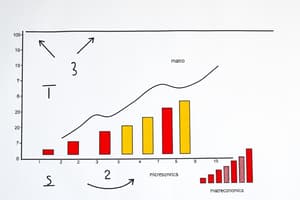Podcast
Questions and Answers
What is the primary focus of microeconomics?
What is the primary focus of microeconomics?
- Inflation and unemployment rates
- Individual consumers and businesses (correct)
- National income and economic growth
- Global trade and investment
Which economic concept represents the cost of forgoing the next best alternative?
Which economic concept represents the cost of forgoing the next best alternative?
- Market equilibrium
- Elasticity
- Supply and demand
- Opportunity cost (correct)
What type of economy combines elements of both capitalism and socialism?
What type of economy combines elements of both capitalism and socialism?
- Traditional economy
- Command economy
- Social economy
- Mixed economy (correct)
What is the purpose of fiscal policy?
What is the purpose of fiscal policy?
What does the inflation rate measure?
What does the inflation rate measure?
Which economic indicator reflects the total value of goods and services produced in a country?
Which economic indicator reflects the total value of goods and services produced in a country?
How does monetary policy primarily influence the economy?
How does monetary policy primarily influence the economy?
What is defined by the difference between a country's exports and imports?
What is defined by the difference between a country's exports and imports?
Flashcards are hidden until you start studying
Study Notes
Economic Concepts
- Definition: Economics is the study of how individuals, businesses, and governments allocate resources and make choices.
Key Branches of Economics
-
Microeconomics:
- Focuses on individual consumers and businesses.
- Analyzes supply and demand, pricing, and consumer behavior.
-
Macroeconomics:
- Examines large-scale economic factors.
- Concerns national income, inflation, unemployment, and economic growth.
Fundamental Concepts
-
Supply and Demand:
- Law of Demand: As prices fall, demand generally increases, and vice versa.
- Law of Supply: As prices rise, supply generally increases, and vice versa.
-
Market Equilibrium:
- The point where supply equals demand.
- Prices stabilize at this point.
-
Elasticity:
- Measures how quantity demanded or supplied responds to price changes.
- Types: Price elasticity of demand, income elasticity, and cross-price elasticity.
-
Opportunity Cost:
- The cost of forgoing the next best alternative when making a choice.
Economic Systems
-
Capitalism:
- Private ownership of production.
- Market-driven economy.
-
Socialism:
- Collective or government ownership of production.
- Redistributes wealth to achieve equity.
-
Mixed Economy:
- Combines elements of capitalism and socialism.
- Government and private sectors jointly influence economic activities.
Key Economic Indicators
-
Gross Domestic Product (GDP):
- Total value of goods and services produced in a country over a specific period.
-
Unemployment Rate:
- Percentage of the labor force that is unemployed and actively seeking work.
-
Inflation Rate:
- The rate at which the general price level of goods and services rises, eroding purchasing power.
Monetary and Fiscal Policy
-
Monetary Policy:
- Managed by the central bank (e.g., the Federal Reserve).
- Influences money supply and interest rates to control inflation and stabilize currency.
-
Fiscal Policy:
- Government spending and taxation decisions.
- Aims to influence economic activity and manage public debt.
International Economics
-
Trade Balance:
- Difference between a country's exports and imports.
-
Exchange Rates:
- Value of one currency in terms of another.
- Influences international trade and investment.
-
Globalization:
- Increasing interdependence of world economies.
- Driven by trade, investment, and technology.
Economics
- The study of how individuals, businesses, and governments allocate resources and make choices.
Microeconomics
- Focuses on individual consumers and businesses.
- Analyzes supply and demand, pricing, and consumer behavior.
Macroeconomics
- Examines large-scale economic factors.
- Concerns national income, inflation, unemployment, and economic growth.
Supply and Demand
- Law of Demand: As prices fall, demand generally increases, and vice versa.
- Law of Supply: As prices rise, supply generally increases, and vice versa.
- Market Equilibrium: The point where supply equals demand.
- Prices stabilize at this point.
Elasticity
- Measures how quantity demanded or supplied responds to price changes.
- Types: Price elasticity of demand, income elasticity, and cross-price elasticity.
Opportunity Cost
- The cost of forgoing the next best alternative when making a choice.
Capitalism
- Private ownership of production.
- Market-driven economy.
Socialism
- Collective or government ownership of production.
- Redistributes wealth to achieve equity.
Mixed Economy
- Combines elements of capitalism and socialism.
- Government and private sectors jointly influence economic activities.
Gross Domestic Product (GDP)
- Total value of goods and services produced in a country over a specific period.
Unemployment Rate
- Percentage of the labor force that is unemployed and actively seeking work.
Inflation Rate
- The rate at which the general price level of goods and services rises, eroding purchasing power.
Monetary Policy
- Managed by the central bank (e.g., the Federal Reserve).
- Influences money supply and interest rates to control inflation and stabilize currency.
Fiscal Policy
- Government spending and taxation decisions.
- Aims to influence economic activity and manage public debt.
Trade Balance
- Difference between a country's exports and imports.
Exchange Rates
- Value of one currency in terms of another.
- Influences international trade and investment.
Globalization
- Increasing interdependence of world economies.
- Driven by trade, investment, and technology.
Studying That Suits You
Use AI to generate personalized quizzes and flashcards to suit your learning preferences.




